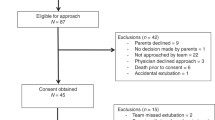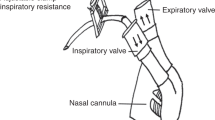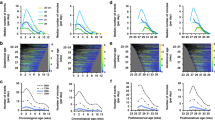Abstract
Objective:
A common clinical impression is that both gastroesophageal reflux (GER) and cardiorespiratory events increase after feeding in preterm infants. We aimed to measure objectively the effects of feeding on GER, apnea, bradycardia and desaturations.
Study Design:
We conducted a retrospective review of premature infants with a gestational age of 23 to 37 weeks at birth and a post-conceptional age of 34 to 48 weeks, who were referred for multichannel intraluminal impedance (MII), pH probe and 12-h apnea evaluation. Cardiorespiratory and GER event rates during pre- and post-feeding intervals were compared.
Result:
Thirty-six infants met the inclusion criteria. More GER events occurred after a feed than before (P=0.012). After feeds, reflux was less acidic and higher in the esophagus (P<0.05). In contrast, the rates of apnea, bradycardia and desaturations were not altered by infant feeding. Apnea of >5 s occurred at a median frequency of 0 (range 0 to 3) events per hour before a feed and 0 (0 to2) events per hour after a feed (P=0.61).
Conclusion:
The frequency, height and pH of GER are significantly altered by feedings in preterm infants. However, the common clinical impression that apnea, bradycardia and desaturations are more prevalent after feeding is not supported.
This is a preview of subscription content, access via your institution
Access options
Subscribe to this journal
Receive 12 print issues and online access
$259.00 per year
only $21.58 per issue
Buy this article
- Purchase on Springer Link
- Instant access to full article PDF
Prices may be subject to local taxes which are calculated during checkout
Similar content being viewed by others
References
Herbst JJ, Minton SD, Book LS . Gastroesophageal reflux causing respiratory distress and apnea in newborn infants. J Pediatr 1979; 95: 763–768.
Spitzer AR, Boyle JT, Tuchman DN, Fox WW . Awake apnea associated with gastroesophageal reflux: a specific clinical syndrome. J Pediatr 1984; 104: 200–205.
Menon AP, Schefft GL, Thach BT . Apnea associated with regurgitation in infants. J Pediatr 1985; 106: 625–629.
Harris P, Munoz C, Mobarec S, Brockmann P, Mesa T, Sanchez I . Relevance of the pH probe in sleep study analysis in infants. Child Care Health Dev 2004; 30 (4): 337–344.
Peter CS, Sprodowski N, Bohnhorst B, Silny J, Poets CF . Gastroesophageal reflux and apnea of prematurity: no temporal relationship. Pediatrics 2002; 109 (1): 8–11.
Mousa H, Woodley FW, Metheney M, Hayes J . Testing the association between gastroesophageal reflux and apnea in infants. J Pediatr Gast Nutr 2005; 41: 169–177.
Wenzl TG, Schenke S, Peschgens T, Silny J, Heimann G, Skopnik H . Association of apnea and nonacid gastroesophageal reflux in infants: investigations with the intraluminal impedance technique. Pediatr Pulmonol 2001; 31 (2): 144–149.
Di Fiore JM, Arko M, Whitehouse M, Kimball A, Martin RJ . Apnea is not prolonged by acid gastroesophageal reflux in preterm infants. Pediatrics 2005; 116: 1059–1063.
Clark RH, Bloom BT, Spitzer AR, Gerstmann DR . Reported medication use in the neonatal intensive care unit: data from a large national data set. Pediatrics 2006; 117: 1979–1987.
Malcolm WF, Gantz M, Martin RJ, Goldstein RF, Goldberg RN, Cotten CM . Use of medications for gastroesophageal reflux at discharge among extremely low birth weight infants. Pediatrics 2008; 121 (1): 22–27.
Koenig JS, Davies AM, Thach BT . Coordination of breathing, sucking, and swallowing during bottle feedings in human infants. J Appl Physiol 1990; 69: 1623–1629.
Yu VY, Rolfe P . Effect of feeding on ventilation and respiratory mechanics in newborn infants. Arch Dis Child 1976; 51: 310–313.
Shivpuri CR, Martin RJ, Carlo WA, Fanaroff AA . Decreased ventilation in preterm infants during oral feeding. J Pediatr 1983; 103: 285–289.
Vandenplas Y, Salvatore S, Vieira MC, Hauser B . Will esophageal impedance replace pH monitoring? Pediatrics 2007; 119 (1): 118–122.
Poets CF, Langer MU, Bohnhorst B . Effects of bottle feeding and two different methods of gavage feeding on oxygenation and breathing patterns in preterm infants. Acta Paediatr 1997; 86: 419–423.
Singer L, Martin RJ, Hawkins SW, Benson-Szekely LJ, Yamashita TS, Carlo WA . Oxygen desaturation complicates feeding in infants with bronchopulmonary dysplasia after discharge. Pediatrics 1992; 90: 380–384.
St-Hilaire M, Nsegbe E, Gagnon-Gervais K, Samson N, Moreau-Bussiere F, Fortier PH et al. Laryngeal chemoreflexes induced by acid, water, and saline in nonsedated newborn lambs during quiet sleep. J Appl Physiol 2005; 98 (6): 2197–2203.
Downing SE, Lee JC . Laryngeal chemosensitivity: a possible mechanism for sudden infant death. Pediatrics 1975; 55: 640–649.
Magista AM, Indrio F, Baldassarre M, Bucci N, Menolascina A, Mautone A et al. Multichannel intraluminal impedance to detect relationship between gastroesophageal reflux and apnoea of prematurity. Dig Liver Dis 2007; 39 (3): 216–221.
Lopez-Alonso M, Moya MJ, Cabo JA, Ribas J, del Carmen Macias M, Silny J et al. Twenty-four-hour esophageal impedance-pH monitoring in healthy preterm neonates: rate and characteristics of acid, weakly acidic, and weakly alkaline gastroesophageal reflux. Pediatrics 2006; 118 (2): e299–e308.
Condino AA, Sondheimer J, Pan Z, Gralla J, Perry D, O'Connor JA . Evaluation of infantile acid and nonacid gastroesophageal reflux using combined pH monitoring and impedance measurement. J Pediatr Gastroenterol Nutr 2006; 42 (1): 16–21.
Mitchell DJ, McClure BG, Tubman TR . Simultaneous monitoring of gastric and oesophageal pH reveals limitations of conventional oesophageal pH monitoring in milk fed infants. Arch Dis Child 2001; 84: 273–276.
Acknowledgements
This research was approved by the Institutional Review Board of University Hospitals.
Author information
Authors and Affiliations
Corresponding author
Rights and permissions
About this article
Cite this article
Slocum, C., Arko, M., Di Fiore, J. et al. Apnea, bradycardia and desaturation in preterm infants before and after feeding. J Perinatol 29, 209–212 (2009). https://doi.org/10.1038/jp.2008.226
Received:
Revised:
Accepted:
Published:
Issue Date:
DOI: https://doi.org/10.1038/jp.2008.226
Keywords
This article is cited by
-
Quantitative Real-Time Assessment for Feeding Skill of Preterm Infants
Journal of Medical Systems (2017)
-
Design of wireless multi-parameter monitoring system for oral feeding of premature infants
Medical & Biological Engineering & Computing (2016)
-
Proton Pump Inhibitors in Pediatrics
Pediatric Drugs (2013)



